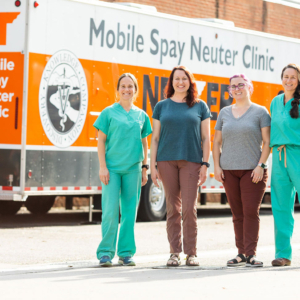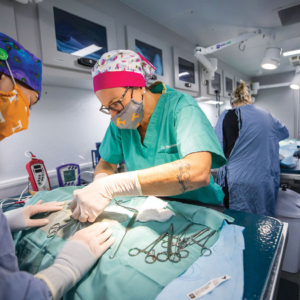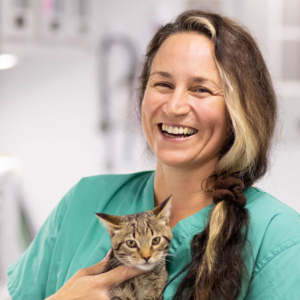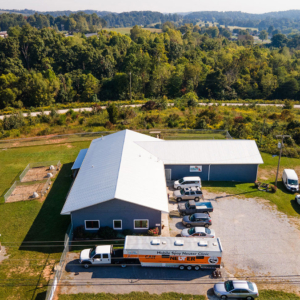Jennifer Weisent and UT College of Veterinary Medicine’s Shelter medicine team partner with local shelters to provide critical services for homeless animals and hands-on surgical experience for students.
Jennifer Weisent wasn’t allowed a pet growing up in New York City, but that didn’t stop her love for animals. For a first-grade project, she interviewed a local animal shelter’s veterinarian—igniting her passion for animal welfare and eventually leading her to UT.
After spending several years as a practicing vet, Weisent came to UT and earned a PhD in epidemiology. She then began working with the College of Veterinary Medicine’s mobile clinic, teaching veterinary students how to spay and neuter shelter cats and dogs. Now a clinical assistant professor of shelter medicine, Weisent works to help the overwhelming homeless animal population in East Tennessee through the mobile clinic, which she helped to rapidly expand since joining the faculty full time in 2017.
“Within those first six months, we went from five shelters to nearly 20 different organizations that we work with,” she explains. “We’ve been able to develop deep partnerships with shelters and rescues in our local community. We want to improve animal welfare in East Tennessee, whether that be breaking down language barriers for people to find bilingual veterinarians, offering spay and neuter services to pet owners who may be homeless, or working with shelters to set up surgical suites.”
The UT Spay and Neuter Mobile Clinic’s teamwork has led to more than 17,000 cats and dogs being spayed and neutered in East Tennessee since 2013—which ultimately means lives saved.
“We still have shelters in East Tennessee that have no choice but to take in animals and euthanize them, even if they are healthy and have no other issues, because there’s no space,” says Weisent. “The majority of shelters are not allowed to let an animal out the door without being spayed or neutered. If they don’t have help, it doesn’t get done. So every single surgery that our clinic and students perform gets an animal on the adoption floor.”
Serving a Region
The Spay and Neuter Mobile Clinic’s work began in 2013, when T’ Fisher founded UT’s Companion Animal Initiative in Tennessee, or CAIT, and established an early version of the mobile clinic through an elective course in partnership with Young-Williams Animal Center. The course’s popularity highlighted an opportunity to fulfill a need of animal shelters in the region and provide students with hands-on experience in surgery and anesthesia. At the time, it was taught by Weisent and other outside veterinarians.
“The student and shelter appreciation were enormous,” said Weisent. “It was an elective, but the students said it was hands-down one of the most important rotations they had taken for clinical skills, understanding of surgery, and lots of techniques—also just the warm and fuzzies.”
A few years after that teaching experience, Weisent discovered that UT was hiring for a full-time faculty member in Shelter Medicine. “I was like, Is that real? I just went for it.”
Once she joined the mobile clinic team full time, Weisent helped widen the rapport and trust between UT and the shelters. The clinic has grown exponentially—from performing 893 spay and neuter procedures at five Knoxville-area shelters in its first year to its current scope, serving 19 shelters and organizations in 12 East Tennessee counties.
In addition to expanding the clinic’s reach, Weisent and Clinical Assistant Professor Rebekah DeBolt, her shelter medicine colleague, worked to make the elective a core requirement for fourth-year students. When the change was adopted in 2018, their course size quadrupled, creating a new challenge for managing rotations. The pair designed a methodology for two-week rotations, taking four students out to shelters with surgical suites while another set of students worked in the mobile unit.
“It was like the Wild West for us. We would rent vans for two weeks from fleet management, pack all the equipment we could possibly need into tubs, and go out to county shelters, rotate the students into surgery, assist with any medical concerns, and load back up,” recalls Weisent.
Spending so much time at the shelter, the team realized they could help shelters by increasing operating suite size or redesigning space in locations that didn’t have any capacity for surgery.
“If you think about this region as being metropolitan, within an hour-and-a-half radius of Knoxville, it makes sense to equip the shelters as opposed to driving a giant vehicle everywhere all the time,” Weisent says. “I wrote grants to secure money to install surgical units, as well as a van for our team to continue the work. It’s a vision of How do we get everyone outfitted? It allows us to start mobilizing ourselves to be more efficient.”
After a year of planning and collaboration with Weisent and DeBolt, the Animal Shelter of Sullivan County in September 2021 opened its own surgical suite featuring three tables with an adjoining prep room, lab station, and recovery area. DeBolt has offered in-depth consultations with other area shelters in Campbell, Cocke, Hamblen, Jefferson, and Washington Counties.
“It’s super exciting because certain shelters have volunteers, but not enough who are willing or able to transport animals to us. It usually falls to shelter staff or animal control officers to do it. It is a great benefit to have surgical suites and means veterinarians in the area can also help the shelters on site,” says Weisent.
Impacting Future Veterinarians
In the three years since the mobile clinic rotation course became a core requirement, more than 350 veterinary students have completed the rotation.
Lindsey Elster, who graduated with her Doctorate of Veterinary Medicine degree earlier this year, knew she wanted a veterinary program that offered a shelter rotation when she applied to UT. Now she’s seen the benefits it provided to all her classmates, regardless of their interest in shelter medicine.
“Ninety percent of us are going to have to do surgery when we get out,” she says. “Probably half of our class might go into that rotation and have that be their first surgical experience that is not on a model or watching over a clinician.
“You really learn how to work with different types of animals, whether they’re scared or fractious or feral. You can work with them, learn how to handle them properly, and show them compassion and kindness. By day 14, I was focusing on fine motor skills. I think learning how to do that and do physical exams on those animals was one of the best experiences and prepared me for a variety of different animals when I graduated.”
For Elster, who now practices as a mixed animal veterinarian, that rotation put her a step ahead of graduates from other veterinary schools.
Weisent says it is an honor to teach future veterinarians. “This field is huge and humbling, and they are going to experience so many unexpected situations. It is important to me that my students know I’m their biggest fan. I want them to leave our rotation feeling empowered to keep learning and to do what they love. Our rotation is about creating a partnership and teaching our students to create a rapport with the animal welfare community and take responsibility as leaders in the field.”





